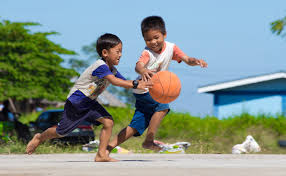Before any game an athlete needs to prepare.
Category: #Healthy Childrlen

Uniform? Shoes? Water bottle? Let’s go!
But more should happen long before leaving for the game.
Any athlete knows he needs to fuel his body. This is essential to deliver the sports response he has practiced for. Your athlete may remember all the plays. But is his body able to deliver?
Let’s start with Nutrition for Child Athletes:
The meals the day before do count. The body is not functioning only on today’s foods. It is also using what you fed it yesterday.
So how was yesterday’s meals? Yes, a good athlete will always start with yesterday’s meals. Just thinking you can “fuel up” in the morning does not work.
Make a good meal for everyone. Include the Food Rainbow and also good Carbs at every meal. Start by just thinking colors: Make your dinner plate colorful. Go for the basic colors.
Food Rainbow
Remember years ago how schools taught about the Food Rainbow? Choose something from each color group for your meals. This ensures that your body has a good foundation to work with.
I like to serve a fresh vegetable: slice tomato or raw carrot. Include in the main portion something yellow and dark green: peas and corn? As for dessert: sliced fruit or a fruit bowl: Some grapes and a sliced orange. Think color when you put your meal together.
There are many good reasons for this coloration. Not only does it make eating more attractive (we all eat with our eyes!), it is nutritious.
We should always try to eat from every color spectrum throughout the day.
There are other reasons for the colors to be important.
The importance of the colors in our foods:
What do the colors bring to our plate?
Reds: such as tomatoes, strawberries, and red beans contain vitamin C and vitamin A. They also contain potassium and antioxidants.
What are antioxidants: Antioxidants are compounds that neutralize free radicals. Free radicals are unstable molecules that can damage cell membranes and other structures. A diet rich in antioxidants can help prevent diseases, such as common colds or this winter’s flu.
Yellow or Orange: include carrots, peaches, squash and pineapple. All loaded with vitamins C and A, and potassium. These vitamins help enhance vision.
White: Mushrooms, bananas, onions, leeks, cauliflower are good for your heart and help control cholesterol. Cholesterol is also important for children as children are becoming heavier in weight.
Green: are dark green leafy vegetables: spinach, broccoli, brussel sprouts are good choices. Green vegetables also help maintain vision health, strong bones and teeth. Green means lots of Vitamin K which aids in blood clotting process. These vegetables also contain potassium. Other green vegetables: avacado, green beans, pears, cucumbers, apples, Romaine lettuce, honeydew melon, celery and green grapes.
Leeks and cauliflower make a great soup!
Blue/purple: are many fruits and vegetables that can get overlooked. These include cranberries, purple grapes, raisins, and eggplant. Also beets, plums, black berries and blueberries. All of these help the urinary tract stay health. The encourage good memory functions and promote healthy aging.
Blue/purples fruits and vegetables is the food group often omitted. The health benefits of this group should be a part of our daily diet as much as an apple or a banana.
Try to choose foods high in fiber as they will give greater food satisfaction.
Fresh is always better than cooked. Try not to use a lot of oil or fry. Steaming or grilling is the best. When you boil vegetables, you leach out nutrients. Pouring out the water, also pours out nutrition. (Perhaps save the water for a soup base.)
If you can’t get fresh fruits or vegetables, frozen does work. Most fruits and vegetables are flash-frozen where they are picked to keep nutrition.
Eat dried fruits in moderation. And if you are counting calories, go for smaller pieces of fruits as dried fruits can be higher in calories.
Eating the rainbow each day gives our body any needed nutrients to fuel the day and the day after.
Is there a Carbohydrate wheel?
A great athlete will start by eating nutritionally good the day before the game! Just eating a good breakfast is no guarantee of good performance.
Good performance starts before the day of the game. When an athlete is “is season,” they need to be eating well every day.
An athlete’s dinner should include the suggestions shown above on the plate.
Good carbs are: whole wheat minimally processed breads, rice, pasta, and starchy vegetables (peas, potatoes, yams, squash, red beans).
It is common for HS football teams to have a spaghetti night the day before a game.
Why all this talk about nutrition when I started with student athletes?
You don’t have to be playing a sport to know the importance of every day nutrition. We do get a lot from our foods. Just not as much as Mom and Dad or Grandparents did.
We have talked about nutrient loss in our soil. Fortify yourself with foods rich in good nutrition. However also add a multiple vitamin supplement. This is especially important if you are out with people or in crowds.
Crowds like to share. Parents and families and friends are in the audience. The bleachers can be full. And everyone is cheering and having a great time! And they are also sharing whatever their body is working on.
Be ready for the assault. Make the nutrition for your athlete important for the whole family.
Foods the day of the game are important for your athlete.
Back to the subject:
If you want to help your child do well during the game, start with a good breakfast.
Prepare a meal that has good hydration, and plenty of complex carbohydrates. A baked potato is a good start. Add some butter. Or a serving of rice and beans with perhaps an egg scrambled in. Add some onions or leeks? This is where a whole fruit juice is good. Hydration is important.
Don’t forget Oatmeal with fruit. Oatmeal is a great complex carbohydrate.
Carbohydrates are fuel for the game.
Forget the sausage and bacon and eggs. Fats are hard to digest and can create problems during activity. Focus on good carbohydrates. If you are not certain which ones, let’s chat!
Make certain your athlete has good hydration.
Start hydration hours before they get to the game. An athlete should have at least 2 glasses of water 2-3 hours before the game.
Consider an electrolyte drink. I recommend Shaklee’s Performance. It was designed for NASA, not a football team. It still ranks as the best drink and is used by high performance athletes around the world.
Monitor the color of your child’s urine. It should be a pale yellow. Dark yellow means the child is a bit dehydrated. More hydration is needed.
When an athlete is dehydrated, their face can get very red and is usually is not a cause for concern. If the flushed skin occurs along with other symptoms, such as confusion, it could indicate a heat-related illness. Difficulty breathing or exhaustion might also suggest heatstroke or heat exhaustion. Pay attention to your child’s breathing when their face is flushed.
During the game hydration is important too. A good sports drink will help with balance. It contains three basic components: fluid, carbohydrates (otherwise known as sugar), and electrolytes (usually sodium and potassium). It does not need vitamins or antioxidants. The body only is looking to regain balance of fluids.
Water does not help other than being just a fluid.
During a game, it’s recommended to drink fluids every 15-20 minutes. Take in around 4-8 ounces of water or a sports drink each time.
Fluid intake depends on the intensity of the activity and the climate they are playing in. For longer games, consider a sports drink to replenish electrolytes lost through sweat. Offer a sports drink when the playing area is quite warm.
Teach your child to listen to their body:. As a parent, you should be watching your child for signs of thirst. Don’t wait until your child is very thirsty to drink, as that indicates dehydration is already setting in. Watch that they drink every chance that is available.
Be aware of your child’s needs. Don’t let them “hit the wall.”
In sports, “hitting the wall” occurs when an athlete suddenly becomes fatigued. The exhaustion happens due to depleted carbohydrate stores. If the athlete had started with a sound breakfast, this would not happen.
And many times it is in school sports. This means the athlete ran out of “gas” or not enough carbohydrates to fuel his body.
It is quite tough on the body. A proper recovery should happen after this. (Start the day with a good carbohydrate load: good fibers, good wheats, little sugars.)
After the game: Recovery is very important.
And be certain to follow the game with a recovery drink, Performance/hydation sports drink. I suggest to have a Recovery drink available in the car for when the game is over.
Recovery is just as important as getting ready for the game.
Even though “game day” is over, a good athlete is always preparing for the next game. The athlete needs to eat healthy all season. Keep hydration up. Be aware of your child athletes’s hydration levels. Don’t wait until a dry mouth. Drink before that.
If you want a personalized plan for your athletic child, I’ll be glad to work with you.
References:
https://foodinsight.org./eat a rainbow










Facebook Comments